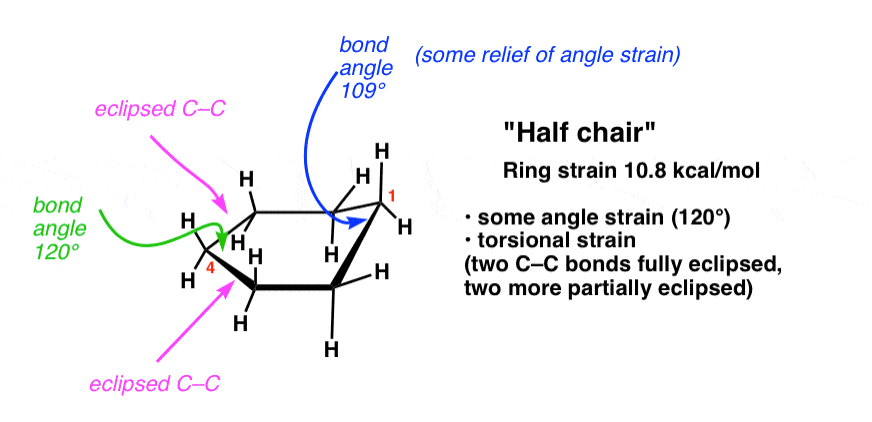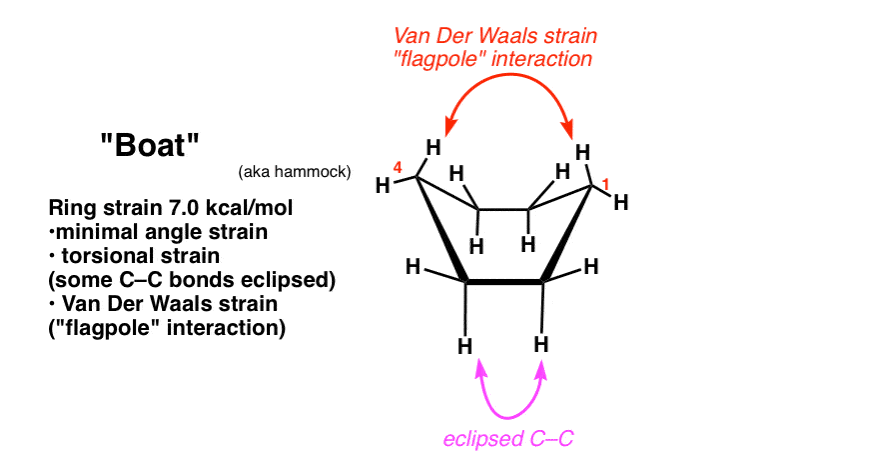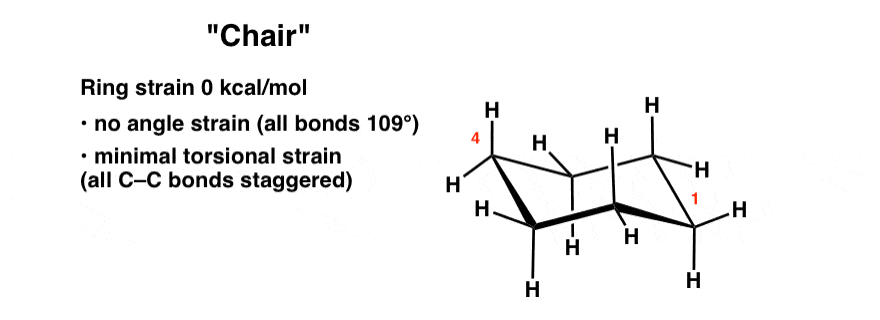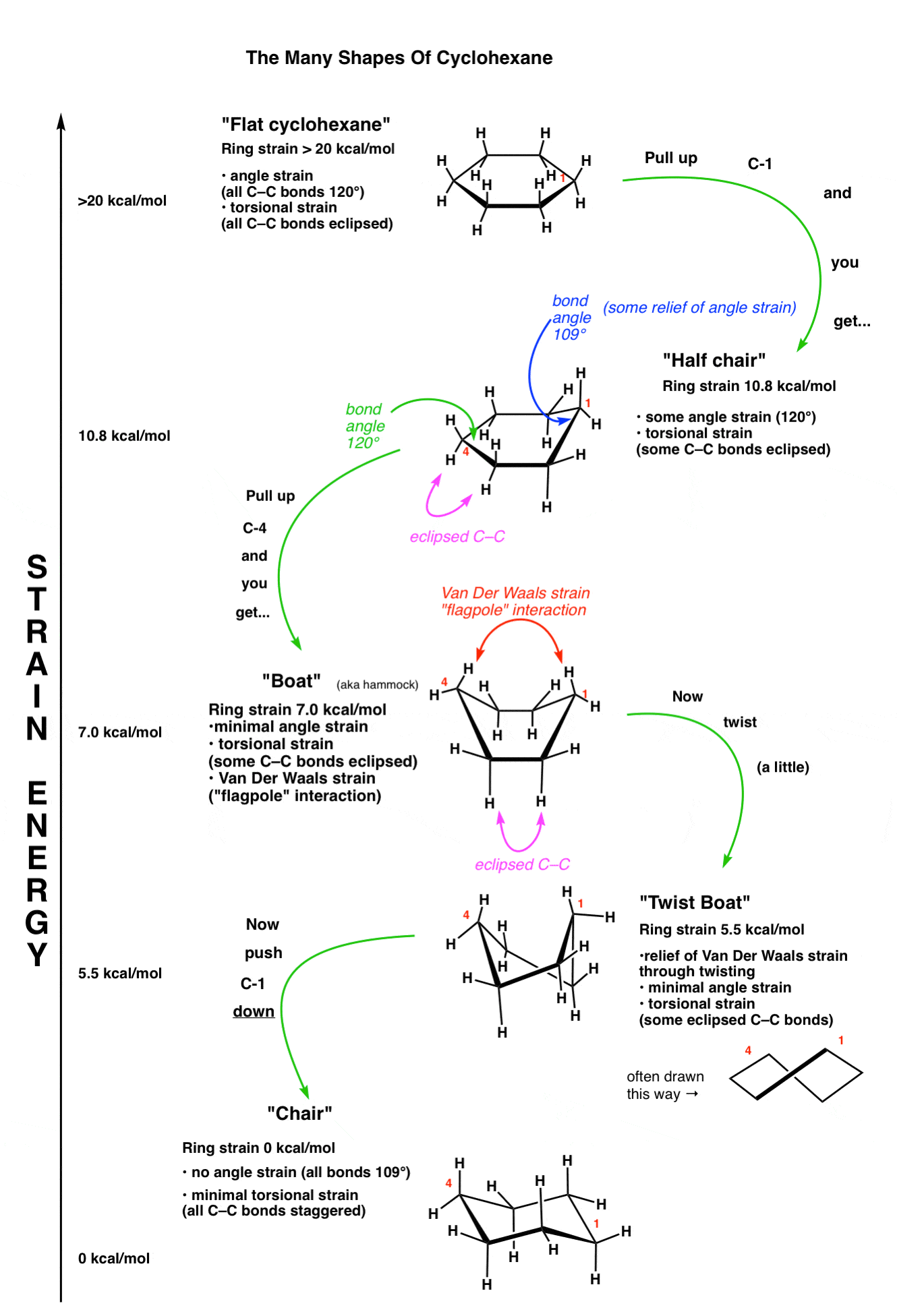Conformations of Cyclohexane (and Cyclopentane)
In the last post, we saw that ring strain of cyclopropane and cyclobutane were 27 and 26 kcal/mol respectively. They are the unhappiest of rings – constrained into uncomfortable angles, with hydrogens forced by geometry to grumpily line up side-by-side with their repulsive neighbours.
The situation for cyclopentane (ring strain: 6 kcal/mol) and cyclohexane (ring strain: 0 kcal/mol) is much happier.
Table of Contents
- Why Aren’t The Bond Angles Of Cyclohexane 120° ?
- The “Flat”, “Envelope” and “Twist” Conformations of Cyclopentane
- The Five Key Conformations of Cyclohexane
- The “Flat” Conformation of Cyclohexane
- The “Half Chair” Conformation of Cyclohexane
- The “Boat” Conformation of Cyclohexane (but it’s actually more like a hammock)
- The “Twist Boat” Conformation of Cyclohexane
- The “Chair” Conformation of Cyclohexane
- Energy Diagram: The 5 Key Conformations of Cyclohexane
- Notes
- (Advanced) References and Further Reading
1. Why Aren’t The Bond Angles Of Cyclohexane 120 Degrees?
First, though, the answer to the riddle from the last post. At first glance, the fact that cyclopentane is more strained than cyclohexane might seem strange because pentagons have bond angle of 108° (very close to the ideal tetrahedral angle of 109°) and hexagons have a bond angle of 120°.
Shouldn’t we expect that cyclohexane is more strained than cyclopentane, not less? What’s going on?

You might see the key fallacy in this line of thinking. What’s the key difference between a pentagon and cyclopentane, or a hexagon and cyclohexane?
The key difference is that the molecules don’t necessarily have to be flat! In fact, as we saw for cyclobutane, “flatness” is disfavored, because it leads to eclipsed C-C bonds, which can have considerable torsional stain. In fact we saw that the dominant conformation for cyclobutane was the “puckered” conformation, where one of the carbons pokes out of the plane created by the other 3 carbons. This relieves torsional strain.
2. The “Flat”, “Envelope”, and “Twist” Conformations Of Cyclopentane
Similarly, for cyclopentane, the “flat” conformation has all of its C-C bonds eclipsed and has considerable torsional strain (about 10 kcal/mol). However, since there is some flexibility, what we in fact observe is two dominant conformations for cyclopentane (of comparable energy), the “envelope” and the “twist”. While each of these conformations has some torsional strain (the C-C bonds are not perfectly staggered), both of these have considerably less torsional strain than flat cyclopentane.
[By the way, these conformations of cyclopentane are not just of purely academic interest – ribose and deoxyribose are 5-membered rings whose conformations have tremendous biological relevance. See Note 1 at bottom]

3. The Five Key Conformations Of Cyclohexane
So that helps to explain why cyclopentane has at least some ring strain.
What about cyclohexane?
Glad you asked! Well, find a comfy thing to sit in – a chair, or a hammock if you will, because over the next few posts, we are going to talk and talk and talk about cyclohexane, and then talk some more. There will be no ring more important to us in this course than cyclohexane.
In this post, however, I just want to sketch out the basics. What are the different conformations (shapes) that cyclohexane has, how do they differ in energy, and why? For best results, I suggest making a model of cyclohexane.
[When many students hear someone say, “make a model”, it’s often like hearing, “go ask your mother”, so really, do what you want. But I promise that it will help as we go through this.]
4. The “Flat” Conformation Of Cyclohexane
Flat cyclohexane is very strained (about 20 kcal/mol). Not only is there angle strain (with internal angles at 120°, above the ideal angle of 109°) but every C-C bond is eclipsed, so there is also tremendous torsional strain. In solution, the flat conformation of cyclohexane is generally of too high an energy to be observed.

5. The “Half Chair” Conformation Of Cyclohexane
If one takes one end of the cyclohexane and “pulls” it up, then we will have a “half-chair” conformation of cyclohexane. If you try this with a model you will note that there will be rotations about 4 different C-C bonds, and this will result in them no longer being completely eclipsed. Furthermore the bond angles upon doing so will more closely resemble the ideal tetrahedral bond angles of 109°.
This results in significantly less torsional strain and angle strain. The strain energy relative to a theoretical “unstrained” ring is about 10.8 kcal/mol.

6. The “BOAT” Conformation of Cyclohexane
Taking the other end of the half-chair and pulling it up creates a structure which resembles a boat (or, as I modestly propose, a hammock). There is no longer significant angle strain, since all internal angles can now be 109 degrees. There is still torsional strain, however, as if you look carefully you will see that along two different C-C bonds, the C-H bonds are all eclipsed [there’s a total of 4 eclipsing H-H interactions].
Furthermore, there is an additional source of strain in the hydrogens of the “prows” of the boat. In the boat conformation these hydrogens are held together in such close proximity that their electron clouds come close enough together to repel, an effect known as Van Der Waals strain. Sometimes this interaction is known as the “flagpole” interaction. The ring strain in the boat is about 7.0 kcal/mol.

7. The “Twist Boat” Conformation Of Cyclohexane
. A significant portion of Van Der Waals strain of the boat can be relieved by a slight rotation of the bonds, resulting in a conformation known as the “twist boat”.
Drawings don’t do it adequate justice – for this one you really need to build a model to see how a slight twisting of the structure can result in less strain. There is still significant torsional strain since there are two C-C bonds about which the hydrogens are not perfectly staggered.

8. The “Chair” Conformation Of Cyclohexane
If one starts with the “half chair” and then pulls the “flat” end in the opposite direction of the carbon that is poking out of the plane, the result is a structure with 4 carbons in the same plane and one carbon each poking above and below the plane. This resembles a deck chair, so it goes by this name.

The chair is a perfectly unstrained molecule. There are no eclipsing interactions; the conformation along each C-C bond is staggered. Furthermore the orientations of the atoms about each carbon are perfectly tetrahedral. Since it lacks ring strain and is of lowest energy, the chair conformation is the dominant conformation that cyclohexane will be found in solution.
Time for some bold type: The chair conformation is the most important conformation of cyclohexane to understand.
9. Energy Diagram: The 5 Key Conformations Of Cyclohexane
Putting all of these conformations together, we can obtain this chart, with highest energy at the top:

If many of these conformations and shapes still seem strange to you, don’t worry! In the next post we are going to talk in more detail about the cyclohexane chair conformation, including how to draw it properly.
